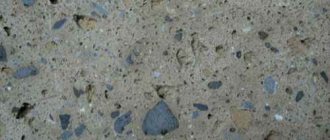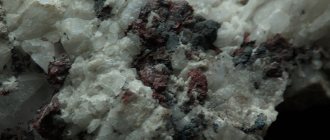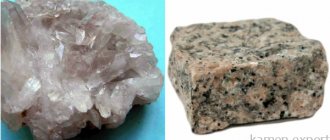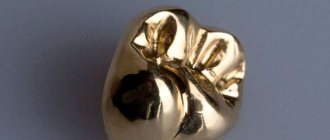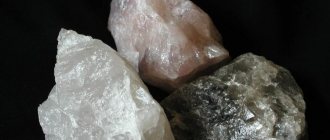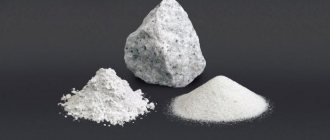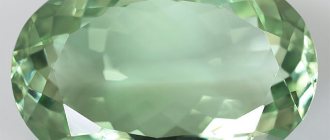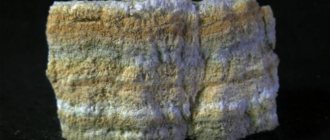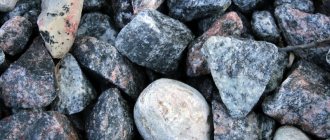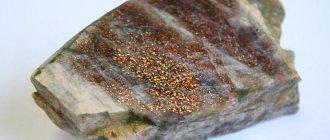The world does not stand still. Technical progress is moving forward by leaps and bounds, new, improved building materials are appearing that are superior to those previously used. However, some of the types known to mankind are still used today, including tuff.
What is tuff?
Tuff is a type of sedimentary rock that has a porous, heterogeneous structure. The mineralogical composition and properties of stones depend on the method of tuff formation. The following types are distinguished:
- Limestone or travertine. It is formed under the influence of geothermal waters on natural materials located in their path. The main component is carbonated lime. During the formation of limestone, it combines with iron, aluminum, and silicon oxide. A porous and light stone is formed. The material travertine has low hardness and is not resistant to moisture.
- Siliceous, or geyserite. Appears when geyser vapors, which contain silicon compounds, fall and cool. The structure is similar to travertine, but does not collapse under the influence of moisture. The stone is hard and durable and may scratch the glass surface.
- Volcanic. The most popular type of tuff. It is formed as a result of the fall, sedimentation and cementation of volcanic ash, pieces erupting from a volcanic vent during an eruption, and various impurities. The photo shows examples of this type.
Calcareous tuff
The rock is also sedimentary. This variety is a polycrystalline homogeneous rock. It consists of carbonate minerals that are found near geothermal springs. The largest deposits of the rock are in Italy; it is also mined in Germany, Armenia, Russia, Iran, Azerbaijan, South Africa, Kyrgyzstan, Turkey and the Transcaucasus.
Calcareous tuff consists of 50% calcium carbonate. Also, in the process of rock formation, it accepts aluminum, iron, silicon oxide impurities and other elements. In its pure form, the breed is white in color. If there is a large amount of impurities, it can be more saturated shades: sand and brown. This type of tuff is quite soft and porous, which makes it easy to machine.
According to its properties, calcareous rock is between limestone and marble. Since the material is not resistant to moisture, its area of use is much narrower than that of the same volcanic tuff. In addition, some varieties are highly sensitive to acids.
Despite the disadvantages of the material, this breed has a warm color scheme, is quite strong, durable and resistant to heat. These qualities are quite in demand during construction. In addition, calcareous tuff has beneficial properties such as heat and sound insulation. Also, it is easy to process, has resistance to weathering and high frost resistance.
It is often used for architectural decoration. Sculptures, landscape design elements, etc. are carved from it. It is often used as a facing material when laying floors. When creating an architectural design in the Antique style, the material is first puttied while preserving its natural color. For this material, moisture and dirt are destructive, so additional treatment with special compounds will be required.
Currently, there are several varieties of calcareous tuff: Italian, Armenian, Turkish and others of origin. As for color, it can be gold, walnut, white and classic.
Composition and structure of volcanic tuff
The volcanic variety has a porous, heterogeneous structure. In one rock fragment there may be inclusions of large or small solid natural materials that differ in color from the base. Tuff contains more than 50% silicon oxide. It also contains oxides of aluminum, manganese and iron. Physico-chemical characteristics of the rock:
- porosity – 21.3 – 46.6%;
- low thermal conductivity;
- Mohs hardness – 3 points;
- compressive strength – up to 60 MPa;
- specific gravity – from 1.4 to 2.5 g/cc;
- high degree of sound insulation.
This type of breed is characterized by resistance to moisture, exposure to sun and wind. The stone is able to withstand sudden temperature changes. It is easy to cut into pieces and give it the desired shape.
In nature, there are different colors of rocks. Depending on the presence of impurities and the percentage of elements of the main composition, there are purple, gray, yellow-brown, pink, red, gray, orange and black specimens.
History and origin of the mineral
Formed in areas where volcanoes are common. When they erupt, small particles of dust, lava, and minerals spread through the air and then settle. As they accumulate, they form tuff layers. They are characterized by a wide distribution over an area, with a thickness of 10–15 meters.
The breed has always been a convenient building material.
Famous architectural monuments, monasteries, and churches were built from it. Houses and public buildings were built in Armenia, Georgia, and Italy.
See historical information about the birthplace of the mineral:
Description and varieties of mineral
Tuff is a stone formed as a result of weathering and precipitation of inorganic compounds. Under the influence of wind, rocks crumble, these crumbs are washed away by water. A solution containing various chemical compounds is formed. As they settle to the bottom, they accumulate, compress, and form stone.
There are several types of breed:
- volcanic tuff - formed from ash, pieces of magma thrown out during a volcanic eruption;
- calcareous tuff - formed in water saturated with calcium carbonate;
- siliceous tuff - settles on the ground near hot springs containing silicon.
In underground caves, the mineral forms stalactites and stalagmites.
The color of the breed depends on its origin. Volcanic has a pink color. Limestone is painted in yellowish, creamy tones. Siliceous is usually white or yellowish. The tuff layers contain inclusions of other minerals.
View this publication on Instagram
Publication from Tatyana (@sad__klumba__ogorod) July 10, 2022 at 11:25 PDT
Fake diamond
Artificial diabase facade
Artificial diabase is a decorative material used for cladding facades. Its main characteristics - strength and durability - are in no way inferior to the similar properties of natural stone.
Thanks to its composition, artificial diabase is much lighter than its natural counterpart, but it is more resistant when in contact with modern reagents, practically does not absorb water and is perfectly sanitary.
The process of producing artificial diabase is referred to as “vibration casting”, since the material used is compacted using vibration.
In order for the texture of the artificial stone to closely resemble the pattern of natural diabase, it is cast using special silicone molds.
Using special colors obtained on specialized equipment, artificial stone is painted in tones characteristic of natural minerals.
A building lined with artificial diabase will not only acquire an attractive appearance and additional thermal insulation, but will also be reliably protected from mechanical damage and dampness for several decades.
Positive and negative qualities of the material
The physical and mechanical properties of the building material tuff indicate that it has only one negative quality - high moisture absorption. It is associated with the high porosity of the tuffs. However, if you look from the other side, it makes the stones light and warm. This is a big plus. And tuff structures can be protected from moisture and frost with insulation and exterior finishing. The main properties of tuff stone vary depending on the deposit and are within the following boundaries:
Nature surprises with the colors of tuff. Different places of origin produce tuff rocks of black, brown, red, brown, lilac, orange, green, yellow, purple and other colors and shades.
The best qualities of tuff:
- sufficient strength and long service life;
- excellent sound and heat insulation;
- light weight;
- high resistance to heat and frost.
The stones are easily machined and can be stored in any conditions. With high porosity, the material is not subject to weathering and destruction due to exposure to atmospheric phenomena. It has a rare property - by nature, a loose stone when exposed to air hardens and becomes more durable.
Churches of Svaneti (Georgia)
Churches of Svaneti in North-West Georgia (43°06′ north latitude, 42°24′ east longitude), built by the Svans (people of the Caucasus). In the mountainous areas of Georgia, churches were built from hewn tuff rock. Despite the fact that local tuff is difficult to carve, ornaments, relief images and many elements inside buildings are also made from it. Some of the buildings in Svaneti were built starting from the 9th century, but are still in use today.
Church of Christ, Chvabiani Village, 11th century
Church of Christ, Chvabiani Village, 11th century
Church in the village of Zhamushi, XII century
>
Overview of species
Almost 90% of volcanic tuffs consist of products - emissions from explosive eruptions. Frequently there is movement of clastic material by mud flows and saturation of the rock with secondary minerals. If other impurities predominate, then the tuffs are divided according to their mineral composition into:
- andesitic;
- liparitic;
- basalt;
- trachytic.
Tuffs can be sintered or cemented; their strength characteristics depend on the method of formation. Sintered rocks are stronger than those cemented with natural cements.
Based on density they are divided into:
- the tracks are tightly compressed;
- pozzolans are loose.
Natural stones: pros and cons
Minerals taken from the natural environment have many benefits:
- cheap or even free material for decorations;
- variety of shapes and colors;
- look natural;
- easy to wash and clean;
- can be used to bring any composition into reality.
They have only one drawback: some rocks can change the hardness and acidity of the aquatic environment, sometimes to a critical level. This feature must be taken into account when arranging a home pond.
Sometimes natural stones are coated with dyes and glued together. If the work is done poorly, the composition will collapse and cause deterioration in the health of the fish. Below is a list of breeds commonly used by aquarists:
- Pebbles. Pebbles for an aquarium are a universal decor. Rocks that fall into bodies of water and are exposed to water for a long time acquire rounded shapes. They come in various sizes and colors, with veins and inclusions.
- Sandstone. Sedimentary rock that consists of sand and clay. Sandstone for an aquarium is not always a good decorative option, as it changes the hardness and acidity of the aquatic environment. In addition, some species are very fragile.
- Limestone. The basis of this mineral of sedimentary origin is calcium carbonate. Possible inclusions of magnesium salts and fossils. Has a solid or loose structure. Limestone increases the hardness and acidity of the aquatic environment and quickly becomes overgrown with algae.
- Granite. It is of volcanic origin. Does not release hazardous substances into water. A heavy multi-colored mineral with a mosaic of different colors. Often used by aquarists to build rock compositions. An aquarium with granite stones looks impressive.
- Gneiss. Slate is a type of solid rock that does not affect the water structure and composition. Pebbles with colored stripes can be safely used to create decor.
- Shell rock. The porous formation of compressed mollusk shells is easy to process to create an aquatic landscape. Shell rock is one of the most common rocks for decoration.
- Tuff. This porous rock is based on volcanic ash. Lightweight, durable, comes in a variety of colors. One of the rock varieties is calcareous tuff. A suitable material for arranging a home for fish that love an alkaline environment and many pitfalls.
- Quartzite. Small grains of quartz fused into one pebble. High strength, but at the same time it can be easily divided into parts. Quartz is found in pink and green shades.
- Gabbro-diabase. Stone of volcanic origin is one of the most durable and widespread in nature. Crushed stone is made from it and pavements are laid. The structure is compared to basalt. Does not emit harmful substances, suitable for creating underwater compositions.
- Jasper. A semi-precious solid opaque mineral that is not just a decoration, but also has special energy. The main component of jasper is quartz. It looks especially beautiful in red.
Events[edit]
Tuffs have the potential to be deposited wherever explosive volcanism occurs and therefore have a wide distribution in location and age. [20]
High-silica volcanism[edit]
Rhyolite tuffs contain pumiceous, glassy fragments and small scoria with quartz, alkali feldspar, biotite, etc. Iceland, [21] Lipari, [22] Hungary, [23] the basin and range of the American Southwest, and New Zealand [13] are among the areas where such tuffs are particularly prominent. In the ancient rocks of Wales, [24] Charnwood, [25] etc., similar tuffs are known, but in all cases they are greatly altered by silicification (which filled them with opal, chalcedony, quartz) and devitrification. [26] The frequent presence of rounded, corroded quartz crystals that occur in rhyolitic lavas helps demonstrate their true nature. [8]
Welded ignimbrites can be very voluminous, such as the Lava Creek Tuff that erupted from the Yellowstone Caldera in Wyoming 631,000 years ago. This tuff had an original volume of at least 1,000 cubic kilometers (240 cu mi). [27] The Lava Creek Tuff is known to be at least 1,000 times larger than deposits from the May 18, 1980 eruption of Mount St. Helens, and had a Volcanic Explosivity Index (VEI) of 8, higher than any known eruptions in the last 10,000 years. [28] Ash flow tuffs cover 7,000 square kilometers (2,700 sq mi) of the North Island of New Zealand and about 100,000 square kilometers (39,000 sq mi) of Nevada. Ash flow tuffs are the only volcanic product whose volumes are comparable to those of flood basalts. [13]
Tioga bentonite in the northeastern United States ranges in composition from crystalline tuff to tuffaceous schist. It was deposited as wind-blown ash, which fell over the sea and settled to the bottom. It is Devonian in age and likely originated from a vent in central Virginia, where the tuff reaches a maximum thickness of about 40 meters (130 ft). [29]
Alkaline volcanism[edit]
Trachytic tuffs contain little or no quartz, but much sanidine or anorthoclase and sometimes oligoclase feldspar, sometimes with biotite, augite and hornblende. When weathered, they often become soft red or yellow mudstones, rich in kaolin with secondary quartz. [8] Modern trachytic tuffs have been found on the Rhine (at Siebengebirge) [30] in Ischia [31] and near Naples. [32] Trachyte-carbonatite tuffs have been discovered in the East African Rift. [33]Alkaline crystalline tuffs have been reported from Rio de Janeiro. [34]
Intermediate volcanism[edit]
Andesitic tuffs are extremely common. They are found throughout the chain of the Cordilleras [35] [36] and the Andes, [37] the West Indies, New Zealand, [38] Japan, [39] etc. In the Lake District, [40] North Wales, Lorne, the Pentland Hills, the Cheviots and many other parts of Great Britain, ancient rocks of exactly the same nature are found in abundance. They are red or brown in color; their slag fragments come in all sizes, from huge blocks to the smallest dust granules. The cavities are filled with a variety of secondary minerals such as calcite, chlorite, quartz, epidote or chalcedony; however, in microscopic sections, the nature of the original lava can almost always be determined by the shape and properties of the small crystals that occur in the decomposed glass base. Even in the smallest details, these ancient tuffs closely resemble the modern ash beds of Cotopaxi, Krakatoa and Mont Pele. [8]
Main volcanism[edit]
Diamond Head, tuff cone
Most of the moai on Easter Island are carved from tholeiitic basalt tuff.
Major volcanism usually takes the form of Hawaiian eruptions, which are not explosive and produce little ash. [41] However, interactions between basaltic magma and groundwater or seawater result in hydromagmatic explosions that produce large quantities of ash. They deposit ash cones, which can later cement into tuff cones. Diamond Head, Hawaii, is an example of a tuff cone, as is Kaula Island. The glassy basaltic ash produced by such eruptions quickly turns into palagonite through the process of lithification. [42]
Although normal mafic volcanism produces little ash, the resulting ash can accumulate locally as significant deposits. An example is the Pahala ash tree on the island of Hawaii, which is up to 15 meters (49 ft) thick in some places. These sediments also rapidly change into palagonite and eventually become laterite. [43]
Basaltic tuffs also occur in Skye, Mull, Antrim and other places where Paleogene volcanic rocks occur; in Scotland, Derbyshire and Ireland among the strata of the Carboniferous period and among the still older rocks of the Lake District, the southern uplands of Scotland and Wales. They come in black, dark green or red; vary greatly in degree of coarseness, some of them filled with round sponge bombs a foot or more in diameter; and being often submerged, may contain shale, sandstone, sandstone and other sedimentary material and sometimes fossils. Modern basaltic tuffs are found in Iceland, the Faroe Islands, Jan Mayen, Sicily, Hawaii, Samoa, etc. When weathered they are filled with calcite, chlorite, serpentine, and especially where the lava contains nepheline or leucite, are often rich in zeolites such as analcite, prehnite, natrolite, scolecite, etc. chabazite, heulandite, etc. [8]
Ultrabasic volcanism[edit]
Ultramafic tuffs are extremely rare; their characteristic is an abundance of olivine or serpentine and a deficiency or absence of feldspar and quartz.
Kimberlites[edit]
Occurrences of ultramafic tuff include surface deposits of kimberlites on maars in the diamond fields of South Africa and other regions. The main variety of kimberlite is a dark bluish-green, serpentine-rich breccia (blue earth), which after thorough oxidation and weathering becomes a loose brown or yellow mass ("yellow earth"). [8] These breccias were emplaced as gas-solid mixtures and are typically preserved and mined in diatremes that form intrusive tubular structures. At depth, some kimberlite breccias pass into the root zones of dikes composed of unfragmented rock. Ultramafic tuffs may occur on the surface in maar deposits. Because kimberlites are the most common igneous source of diamonds, transitions from maars to diatremes and root zone dikes have been studied in detail. Diatreme facies kimberlite is more correctly called ultramafic breccia than tuff.
Komatiites[edit]
Komatiite tuffs are found, for example, in the greenstone belts of Canada and South Africa. [44] [45]
Folding and metamorphism[edit]
Remains of ancient Servian walls in Rome made of tuff blocks.
Over time, tuff deposits can be affected by changes other than weathering. Sometimes they participate in folding and become shorn and split. Many of the English Lake District greenshales are finely crushed ash. In Charnwood Forest the tuffs are also schistose and fractured. The green color is due to the high chlorite content. Among the crystalline schists of many regions there are green beds or greenschists which are composed of quartz, hornblende, chlorite or biotite, iron oxides, feldspar, etc., and are probably recrystallized or metamorphosed tuffs. They often accompany masses of epidiorite and hornblende shales, which are the corresponding lavas and sills. Some chlorite shales are also likely to represent altered layers of volcanic tuff. The "Schalsteins" of Devon and Germany include many split and partially recrystallized ash layers, some of which still retain their fragmentary structure, although their lapilli are flattened and elongated. Their vapor cavities are usually filled with calcite, but sometimes with quartz. The most altered forms of these rocks are tabular green chlorite schists; they, however, rarely contain structures indicating their original volcanic nature. These are intermediate stages between fissured tuffs and crystalline schists. [8]
Tuff price
The price of tuff depends on the color of the original rock and the degree of processing of the final blocks. Tuffs can be processed by sawing, grinding, polishing, and artificial aging. The cheapest cost per square meter of sawn tuff will be the most expensive, respectively, polished and artificially aged tuff.
You can buy tuff in bulk, then the price per batch will be significantly reduced. Natural tuff stone is distinguished by a surprisingly wide color palette and a unique texture, with a transition from one color to another: when cut, the stone can resemble the structure of natural wood.
Thanks to its properties, tuffs are becoming an increasingly popular finishing material, whose decorative properties are highly valued by architects and decorators, and whose functional properties are highly valued by builders.
Description and classification of the main types of pyroclastic rocks
There is currently no general classification of pyroclastic rocks. This review takes into account the data of the first volcanological conference in 1959.
Pyroclastic rocks are divided according to the quantitative ratio of volcanic and sedimentary material. Further division is carried out according to the size of the constituent parts, petrographic composition and structure of the fragments, homogeneity and heterogeneity of the rock-forming material, etc. Based on the content of volcanogenic material, pyroclastic rocks are divided into three groups.
1. Volcanic tuffs and tuff breccias (synonym - volcanic breccias) - rocks composed almost exclusively of volcanogenic material (more than 90%).
2. Tuffites - rocks composed of volcanic and sedimentary material. The content of the latter is less than 50%.
3. Tuffaceous rocks (synonym: tuffaceous-sedimentary rocks) - rocks with a predominance of sedimentary material (more than 50%). Some authors classify them as sedimentary rocks.
Tuffs and tuff breccias (volcanic breccias). Tuffs and tuff breccias are pyroclastic rocks in which both fragments and cementing material are the product of volcanic emissions formed during explosive volcanic activity. During secondary changes, which easily occur here due to the porosity of the rock, cementation of the binding material of the tuffs occurs. The processes of carbonatization, silicification, pelitization, chloritization, epidotization and other secondary changes are widely developed. Based on the predominant size of their constituent parts, these rocks are divided into the following groups: 1) tuff breccias (volcanic breccias) - >30 mm; 2) coarse clastic tuffs - 30-5 mm (corresponding to the size of a walnut to a pea); 3) coarse tuffs - 5-1 mm; 4) fine-clastic tuffs - 1-0.1 mm. The debris is visible to the eye. 5) fine clastic tuffs - 0.1 mm. Based on the structure of the predominant fragments, crystalloclastic tuffs and tuff breccias are distinguished. In rocks of this type, there is a sharp predominance (>75%) of minerals that are lava franks ejected during gas explosions. Lithoclastic tuffs and tuff breccias. In rocks of this type, the fragments are represented predominantly (>75%) by rocks, usually effusive, to which fragments of other rocks or minerals may be mixed. A variety of lithoclastic tuffs are vitroclastic (Fig. 1-III), in which the fragments are represented by volcanic glass (Fig. 2-III), as well as ash tuffs (traces, pozzolans). The latter are the most fine-clastic varieties of tuffs and consist of fragments of glass, usually rich in silicic acid; the fragments may be angular or in the shape of hairs, arches, or drops. Among the ash tuffs, pisolite tuffs are distinguished, which are characterized by the presence of small spherical particles, which are probably drops of volcanic glass that were ejected from the lava during explosions. In volcanic breccias and coarse clastic tuffs, lithoclastic material usually predominates; in fine- and fine-clastic tuffs, in vitro- and crystalloclastic material predominates. Based on the petrographic composition of the fragments of extrusive rocks and minerals present in the tuff, as well as the mass that binds them, basalt, trachyte, liparitic and other tuffs are distinguished. For example, basaltic tuff contains fragments of basaltic rocks, fragments of crystals of basic plagioclase, olivine, and pyroxene. Ash tuffs often correspond in composition to liparites and are characterized by a high content of silicic acid. Ignimbrites are unique and widespread pyroclastic rocks in nature, corresponding in composition to quartz porphyries - liparites. Ignimbrites were formed during colossal eruptions of acidic lava that occur from under domes of extruded lava. Under enormous pressure, a mass of hot material, very rich in gases, forms a kind of “suspension”, which sinks to the surface of the earth and is capable of flowing like a liquid stream. In the lower parts of such flows, ■partial melting and sintering of ash particles may occur. The structure of ignimbrites is often intermediate between the structure of tuffs, tuff lavas and ordinary lavas.
Diamond-bearing picrite tuffs, widely developed in Africa and northeastern Siberia, are known as kimberlites. Tuffs and tuffites are extremely diverse rocks in color and appearance. Among the tuffs there are dark, bluish-gray, pink-violet (Artik tuffs of Armenia), brown-gray, green, light violet, greenish (Karadag routes), etc. As a rule, darker tuffs correspond to tuffs of basic ultramafic composition, lighter ones - tuffs of acidic composition. A characteristic feature of most tuffs is their strong secondary changes. The tuffs of the acid series are least altered. Some authors propose to further classify tuffs according to facies conditions into vent facies, near-vent facies, and facies formed at a significant distance from the place of ejection of pyroclastic material (Bykovskaya, Gapaeva, Boretskaya et al., 1959). Tuffites. Tuffites are pyroclastic rocks containing less than 50% sedimentary material (clastic, chemogenic, organogenic). Tuffites and tuffogens are usually formed in an aquatic environment, as evidenced by the admixture of corresponding sedimentary rocks and even marine fauna in them (for example, in shalypteyns). However, tuffites of terrestrial and mixed origin are known. The latter are formed, for example, in cases where mud flows accompanying a volcanic eruption descend from the cone into a water basin and are partly in the aquatic environment, partly in the terrestrial environment (Maleev, 1959a). Tuffites occupy an intermediate position between tuffs and tuffaceous-sedimentary rocks. Tuffites often contain significant amounts of clayey, carbonate and other material, organic remains, and detrital grains. In some tuffites rich in sedimentary material, layering is clearly visible. When enriched with pyroclastic material, tuffites acquire the characteristic features of tuffs. Based on the size of the constituent rocks, tuffites are divided similarly to tuffs. If the pyroclastic material in tuffites is more or less homogeneous in composition, then the tuffites can be called “spilite tuff”, “andesitic tuff”, etc. Tuffogens (tuffaceous-sedimentary rocks). Tuffaceous rocks differ from tuffites conditionally by the predominance of sedimentary material in them (more than 50%). Typical tuffaceous rocks are formed due to the direct deposition of solid products of volcanic eruptions and their mixing with sedimentary material. Most often, they are formed in an aquatic environment at some distance from the center of the eruption and often reveal layering and sorting of material. Based on the size of their constituent parts, tuffaceous rocks can be divided similarly to sedimentary rocks into tuffaceous conglomerates and breccias, tuffaceous gravestones, sandstones, siltstones, and pelites. If the content of pyroclastic material in rocks is less than 10%, the term “tuffaceous” should not be applied to them, but even an insignificant admixture of volcanogenic material should always be noted. When classifying pyroclastic rocks, it is necessary to take into account the degree of redeposition of volcanogenic material. Typical pyroclastic deposits are characterized by the angular shape of volcanic debris due to the fact that they are transported in the air. However, once debris reaches the surface of the earth, it can be carried by water currents. Often this transfer occurs during a volcanic eruption when mud ash flows occur. In particular, this is how the tuff was formed, under which Herculaneum and Pompeii were buried during the eruption of Vesuvius in 79 AD. If such transfer is short-lived, then the pyroclastic particles remain angular. Otherwise, they are gradually rounded up. Pyroclastic rocks of this kind, consisting of slightly rounded volcanic particles, should be distinguished under the name tuffoids and tuffoids. This must be done because deposits of this kind may no longer be simultaneous with volcanic eruptions, occurring during the erosion of loose, but still more ancient tuffs or tuffites and the short-term transport of the resulting fragments. Tuffoids and tuffoids are characterized by the fact that they arise due to the erosion of somewhat older pyroclastic, but not effusive rocks, the destruction of which gives rise to the formation of already normal sandstones of the greywacke type. The latter, however, can also be formed due to a longer transport of pyroclastic material, which in this case becomes sorted and loses its original originality of particle shapes. Origin and geological distribution The formation of all pyroclastic rocks is associated with eruptions of land and submarine volcanoes. Secondary hydrochemical transformations, which easily occur due to the porosity of rocks, are important in the formation of pyroclastic deposits. Pyroclastic rocks are most common in areas that have experienced significant vertical movement. They are most widely developed among thick geosynclinal strata, but they are also found in platform areas (such as kimberlites). In the Lower Paleozoic, especially in the Silurian strata, pyroclastic rocks are observed within the Ural-Tyanynan geosynclinal region. Devonian magmatism is widespread in Altai. In Upper Paleozoic deposits, pyroclastic rocks are known from the Tunguska Formation in Siberia. Kimberlite volcanism of the Siberian Platform occurred over a long period of time from the beginning of the Permian to the Upper Jurassic and Lower Cretaceous. In the Cretaceous, pyroclastic rocks are known in the Far East and Chukotka. In tertiary deposits they are present in the Caucasus, and in quaternary deposits - in Transcaucasia and Kamchatka. Lenses of tuff deposits are known among the Neogene and Quaternary strata of the Voronezh, Kursk and Tambov regions. Ignimbrites are widespread in the Far East, Kazakhstan, the Caucasus (Armenia), and abroad - in Alaska (Katmai region), New Zealand, Japan, etc.
Where is marble found?
The distribution of this breed is quite wide. Marbles from Italy are the most famous. Marble is also widely known
yellowish color from Greece.
In Russia, marble
is mined in the Far East, the Urals, Altai, Karelia and the Krasnodar Territory.
Interesting materials:
How to enter the engineering menu on Android? How to access the root of Android from a PC? How to go to Android settings? How to go to the Download folder on Android? How to access the System folder on Android? How to access developer options on Android? How to enter developer mode on Android? How to enter a hidden game on Android? How to log into your iCloud from Android? How to access downloads on Android?
Formation of pyroclastic rocks and their characteristic features
Volcanic tuff Pyroclastic rocks Pyroclastic rocks are formed during explosive volcanic activity due to the accumulation of mainly solid products of volcanic emissions. Among the material of volcanic emissions, fragments of rocks erupted during an explosion may also be of significant importance; In addition, pyroclastic material is often mixed with normal sedimentary material syngenetic to it, deposited on the land surface (due to water flows) or at the bottom of water basins. The condition that determines the classification of rocks as pyroclastic is the synchronicity of their volcanic eruptions. Pyroclastic rocks are to a certain extent a connecting link between sedimentary and igneous rocks (effusive). Among pyroclastic rocks, the most common are volcanic tuffs, characterized by a sharp predominance of fragments of volcanic origin, in the spaces between which there is often an ash mass consisting of finely ground volcanic glass. Cement is usually formed by the products of hydrochemical decomposition of ash material, which are a siliceous-carbonate, siliceous-clayey mass. In tuffites and tuffogens, the amount of sedimentary material increases and a transition to clastic rocks is observed. On the other hand, tuffs pass through tuff lavas and so-called ignimbrites to normal effusive rocks. Tufolavs are rocks in which fragments resulting from volcanic eruptions are cemented by lava. The main feature of pyroclastic rocks is their unique structure, characterized by 1) the presence of angular fragments of rocks and minerals (ejecta from lavas); 2) heterogeneity of composition and structure; 3) lack of sorting of material; 4) a small amount of cement; 5) the usual lack of well-maintained layering. Only in some (volcanic) tuffs of marine origin can these features be expressed less clearly. For example, due to the deposition of volcanic emissions from the aquatic environment, some sorting of the material and the formation of a layered texture may occur. In general, these rocks are often characterized by irregularity in strike and dip. Pyroclastic rocks are often associated with effusive rocks. Sedimentary rocks that arose during the erosion and redeposition of pyroclastic and effusive rocks are not pyroclastic, but belong to sedimentary rocks proper. This kind of sedimentary deposits are characterized by:
1) known sorting of fragments by size;
2) less angularity (than in tuffs) or even roundness of the fragments;
3) layering;
4) psammitic or psephytic structure;
5) interlayering with normal sedimentary rocks - sandstones, etc.
A typical example of rocks that arose during the erosion and redeposition of tuffs of the main series are greywackes
Types of tuff with photos
Volcanic tuffs are a large group of rocks, consisting of many subtypes. They are classified according to different criteria: density, characteristics of the fragments from which they consist, composition. In the photo you can see several varieties of this rock.
The table provides a brief description of the types of tuff.
| Classification sign | Breed subspecies | Characteristic |
| Density | Trails | Highly compressed, high-density volcanic materials |
| Pozzolans | Loose material | |
| Nature of the debris | Vitroclastic | Volcanic glass mixed with various substances |
| Lithoclastic | Consists of parts of rocks | |
| Crystalloclastic | Formed from fragments of several minerals and crystals | |
| Compound | Trachytic | It contains potassium feldspar |
| Basaltic | Formed from destroyed basalt particles and various impurities | |
| Liparite | Based on volcanic glass and feldspars with a small silica content | |
| Andesitic | The mineralogical composition is dominated by silicon and aluminum oxides | |
| Debris size | Fine clastic | Grouped depending on the size of the forming elements |
| Medium clastic | ||
| Coarse clastic | ||
| Coarse clastic |
The basalt variety is credited with magical and healing properties. It is used in the treatment of diseases associated with the gastrointestinal tract and cardiovascular system. Ancient magicians enhanced the effect of rituals with the help of a “lava stone.”
Types of tuff
The following types of tuff are distinguished:
- volcanic;
- limestone;
- siliceous.
The volcanic variety of tuff is divided according to the nature of the fragments, and also according to composition into:
- basalt;
- andesitic;
- liparitic and others.
Calcareous tuff
These are the already mentioned travertines. They form in sediments near springs saturated with lime carbonate. Travertine stone unevenly layers on already formed deposits and can even cover plants growing nearby. It is characterized by a yellow-brown, flesh-colored color. It is mainly composed of calcium carbonate minerals. It lends itself well to grinding and polishing, which makes it possible to use it as a building and facing stone. This tuff is often used in agriculture for liming the soil.
Siliceous tuff
It is also called geyserite from its place of origin. This is a chemogenic rock with a porous, dense structure and great hardness. When you run it across the glass, it leaves a scratch. Geyserite has a variety of colors: gray, white, brown, pink, yellow, red and others. This is due to the presence of oxides of iron and manganese, which can smoothly transform into each other. They find it near hot springs, where there is a chemical precipitate with silica dissolved in it. Siliceous tuff does not react with hydrochloric acid, unlike calcareous tuff.
Volcanic tuff
These are debris and other elements thrown to the surface during a volcanic eruption and compacted. Such elements can also be transported by water flows. It is possible to include non-volcanic rocks, but also breccias - broken elements of rocks consisting of angular cemented crumbs. This tuff is very easy to process. Using an ordinary ax or saw, you can make high-quality building material from it - magnificent wall stone.
The rich, bright colors give the buildings an unusually beautiful exterior. Most of the Easter Island statues are made from this type of tuff. Many centers of religious culture and art buildings in Yerevan are made of this material, which is lightweight and has increased frost resistance. The same country is home to one of the largest deposits of volcanic tuff in the world.
What is tuff used for?
In the absence of bricks and other building materials familiar to modern people, the rock was used for the construction of:
- walls of houses;
- temples and mosques;
- monasteries;
- public buildings.
Currently, interest in this natural material has not waned. The use of tuff depends on its place of origin. With the help of volcanic and calcareous types, facing work is carried out, but siliceous is suitable only for interior decoration. Armenian tuff is used to cover stoves, pipes and chimneys, because it can withstand temperatures up to 8000°C.
Applications of tuff
Tuffs are used in construction. Many buildings in Armenia, Russia, France, Italy, and Azerbaijan are built from tuff. The widespread use of this rock is due to its lightness and strength. Tuffs are easy to process and polish; no sophisticated technological tools are required.
Volcanic and calcareous tuffs are used for facing work, and siliceous tuffs are used only for interior decoration. Armenian volcanic tuffs are used for lining stoves, pipes and chimneys, temperatures in which do not exceed 8000 C.
Specially prepared crushed tuffs are used as aggregates in lightweight concrete. Such aggregates are made from waste from the production of facing slabs and can be produced directly at the tuff deposit.
Such tuff additives in cement contribute to the resistance of constructed objects to seawater activity. In addition to these applications, crushed tuff is added to paint and varnish products.
Construction tuffs provide good heat and sound insulation of buildings. They are also characterized by high water resistance and frost resistance. Tuffs are used in construction in harsh climatic conditions, in the mountains.
Despite their light weight and ease of installation, tuffs are durable and wear-resistant. These properties ensure the universal use of tuffs for construction. Buildings decorated with multi-colored tuffs look interesting: yellow, pink, purple, brown, red, orange, black.
A wide range of colors allows the use of tuffs with both natural and artificial finishing materials for building facades to give an individual, unique appearance.
In interior work, decorators use tuffs to decorate fireplaces, cellars and even walls, for external masonry and for landscape design. Tables and chairs, decorative columns, balusters, railings, gazebos, steps and baseboards, cabinets and walls will enhance the effect of naturalness and naturalness of natural stone. In offices and massage rooms, tuff is used to decorate walls: it maintains an optimal microclimate in the room and isolates the room from extraneous sounds.
Landscape designers use tuff to build swimming pools and aquariums. Tuff is able to accumulate solar heat, and therefore serves as an ideal material for lining the bottom and walls of pools. Houses made of tuff look very advantageous, no matter what style of future cottage or country estate is chosen. A house made of tuff is almost eternal.
Armenian churches high in the mountains are exposed to huge temperature changes throughout the year and have stood unchanged for 7-8 centuries. The Colosseum in Rome was built from calcareous tuffs mined in Italy, and the Noravank monastery complex in Armenia.
Deposits and production
The deposits are located near extinct and active volcanoes. The largest mining of volcanic tuff is carried out in Armenia. Armenian tuff is famous for its rare colors - pink and purple. There are also black and brown varieties in this country. The pinkish species is found in Russian Kabardino-Balkaria. Deposits of yellow-brown tuffs have been discovered in Kamchatka.
The rarest golden tuffs are mined in Georgia. Yellow ones are common in Iran. Various species have also been found in other countries: the USA, Iceland, Italy, New Zealand, Azerbaijan, Kyrgyzstan, Tajikistan.
Deposit development is carried out using the open pit method. Mining is carried out in those places where the soil is best suited to influence. Formations of volcanic origin are located in separate layers or are found together with mineral veins.
Types and characteristics
Tuff is classified into different types according to:
- composition of the material - andesite, dacite, rhyolite, basalt and other (sedimentary) volcanic rocks formed during the process of ejection and subsequent compression;
- mineral and chemical parameters;
- texture - some types can be obtained using any available tools, while others stick together to a strong degree of hardening, like obsidian;
- color - from purple-pink to yellow or orange.
At elevated temperatures during a volcanic eruption, strong consolidation of tuff is observed. This material is called welded pyroclastic. It is denser than other types of tuff and has the form of large pieces with foreign small particles - slag, ash, lapilli and other elements of volcanic emissions. In welded tuff you can find crystals (parts or whole pieces), pumice and other substances. Cementing them makes the material as durable as granite.
Properties
The unique physical and chemical composition of volcanic tuff determines its advantages over many popular building materials. It is easy to process, it is simply cut into pieces and layers.
Basic properties:
- porosity;
- low specific gravity;
- high compressive strength (higher than brick);
- hardness;
- good sound insulation;
- low thermal conductivity;
- slight hygroscopicity;
- frost resistance;
- fire resistance;
- durability.
Tuff is valued for its excellent decorative qualities. It has a wide color palette, although the coloring is heterogeneous, interspersed. The color depends on the composition of the effusive rocks of a particular area.
Properties of tuff
This breed has certain properties that allowed it to become a popular building material in ancient times. The walls of the Colosseum were built from it, and St. Peter's Basilica in the Vatican was erected. Tuff is the stone from which the structurally integral churches of Lalibela are made. We are talking about an ancient Ethiopian city, a center of pilgrimage for Christians from all over the world. The tuff structures here date back to the medieval and post-medieval civilization of Ethiopia.
This loose and porous material is very light, which greatly simplifies working with it. It is characterized by low sound and thermal conductivity - one of the main qualities required for buildings. However, it remains partially permeable to water, which somewhat narrows its scope of application. It is well suited for building the frame of a house, but tuff is used less often for cladding.
Processing and application
Volcanic tuff lends itself well to processing. Thanks to this, they learned to use it before the advent of special devices. Many specimens are ground and shaped into slabs and blocks. Some are crushed into powder or pebbles, which will later be added to construction and finishing materials.
Large stones are used as a basis for creating sculptures. In addition, whole specimens are used to decorate parks, personal plots and gardens. The main use of sanded blocks is the construction of houses. Volcanic tuff buildings are durable and warm. Plates made from this material are used for cladding houses for insulation and sound insulation purposes.
Tuff is also used to make tiles used for laying floors. Souvenirs are made from small solid stones. Crushed specimens are added to concrete. The mixture with tuff does not crack and lasts longer. Some types of rock are used in underwater construction. Tuff powder is also used in the production of various paints.
Compound
As a rule, tuffs accompany the outpouring of neutral or acidic relatively viscous lavas. Liquid basic forms rock more often during underwater eruptions. They decompose quite easily into clays.
Since different rocks may occur at eruption sites, the final product may also vary in composition: it may contain more basalt, liparitic, trachytic, andesitic and other particles.
What does it look like
Volcanic tuff is characterized by a clastic-porous structure, low density, heterogeneous composition, and variable color. It can be in the form of dense volcanic tuffs (traces) and loose volcanic ash (pozzolans). This material can be pink, red, purple, yellow, orange, brown, gray and black.
History of appearance
Volcanic tuffs are formed as a result of the explosion of volcanoes and subsequent cementation and compaction. They contain volcanic material in an amount of 90%, the content of tuffites can be 50-90%. If the rock contains less than 50% volcanic material, the name is determined depending on the predominant material, which has a different origin.
The tuff rock may differ in composition and is divided into the following types:
- andesitic;
- liparitic;
- basaltic;
- trachytic.
Sources
- https://MoyKamen.com/vidy/prochie/tuf-kamen.html
- https://stone-stream.ru/interesnoe/vulkanicheskij-tuf-eto.html
- https://stroy-podskazka.ru/tuf/o-vulkanicheskom/
- https://tvoi-uvelirr.ru/chto-takoe-tuf-svojstva-tufa-primenenie-tufa/
- https://natural-museum.ru/rock/%D0%B2%D1%83%D0%BB%D0%BA%D0%B0%D0%BD%D0%B8%D1%87%D0%B5%D1 %81%D0%BA%D0%B8%D0%B9-%D1%82%D1%83%D1%84
- https://womanadvice.ru/tuf-chto-eto-takoe-kak-vyglyadit-gde-dobyvayut-svoystva-dlya-chego-ispolzuetsya
- https://vseprokamni.ru/vidy/drugie/kamen-tuf.html
Siliceous tuff
The rock is formed as a result of the activity of geysers. When steam is formed, silicon precipitates and, after falling to the ground and cooling, eventually turns into a layer of rock. Often this variety can be found under another name - geyserite. There are several varieties of siliceous tuff: gray, white, pink and brown.
Siliceous tuff is a fairly durable material, so much so that it can scratch glass. Its structure resembles a calcareous type of rock, but with one difference - it is not susceptible to the destructive influence of sea water.
The largest deposits are in Kamchatka. However, it is also mined in Iceland, Russia and North America. It, like other types, is used in construction and as a material for creating decorative elements.
